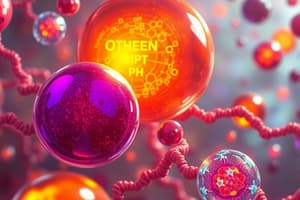Podcast
Questions and Answers
What are enzymes?
What are enzymes?
Biological catalysts
What is the function of Lipase?
What is the function of Lipase?
Breaks down fats into smaller molecules
What is the function of Amylase?
What is the function of Amylase?
Breaks down carbohydrates into simpler sugars
What is the function of Lactase?
What is the function of Lactase?
What is the function of Protease?
What is the function of Protease?
What is the optimal pH?
What is the optimal pH?
Enzymes can work effectively at any pH level.
Enzymes can work effectively at any pH level.
Why do we need to test the pH levels of food?
Why do we need to test the pH levels of food?
What is the pH range?
What is the pH range?
A pH of 7 indicates a basic solution.
A pH of 7 indicates a basic solution.
Acidic solutions have a bitter taste.
Acidic solutions have a bitter taste.
Alkaline is another term for basic.
Alkaline is another term for basic.
Which of these are properties of acids? (Select all that apply)
Which of these are properties of acids? (Select all that apply)
Which of these are properties of bases? (Select all that apply)
Which of these are properties of bases? (Select all that apply)
Match the following pH ranges to their corresponding properties:
Match the following pH ranges to their corresponding properties:
Flashcards
Enzyme
Enzyme
A biological catalyst that speeds up chemical reactions in the body.
Lipase
Lipase
An enzyme that breaks down fats.
Amylase
Amylase
An enzyme that breaks down starches into sugars.
Lactase
Lactase
Signup and view all the flashcards
Protease
Protease
Signup and view all the flashcards
Optimal pH
Optimal pH
Signup and view all the flashcards
pH
pH
Signup and view all the flashcards
Acidic pH
Acidic pH
Signup and view all the flashcards
Neutral pH
Neutral pH
Signup and view all the flashcards
Basic pH
Basic pH
Signup and view all the flashcards
Acid properties
Acid properties
Signup and view all the flashcards
Base properties
Base properties
Signup and view all the flashcards
Study Notes
Enzymes and Acid/Bases
- Enzymes are biological catalysts that speed up reactions in the body, including digestion, metabolism, and energy production.
- Lipase breaks down fats.
- Amylase breaks down carbohydrates, specifically starches.
- Lactase breaks down lactose in milk and dairy products.
- Protease breaks down proteins into amino acids.
Optimal pH
- Each enzyme works best at a specific pH level, called its optimal pH.
- If the pH is too high or too low, the enzyme may not work as well or may stop working completely.
- Testing pH levels in food is important for production and digestion.
pH Scale
- The pH scale measures acidity and basicity.
- It ranges from 0 to 14.
- pH < 7: Acidic
- pH = 7: Neutral
- pH > 7: Basic
Properties of Acids
- Sour taste
- Turns blue litmus paper red
- Reacts with metal
Properties of Bases
- Bitter taste
- Feels slippery and soapy
- Turns red litmus paper blue
- Known as alkaline
Studying That Suits You
Use AI to generate personalized quizzes and flashcards to suit your learning preferences.





